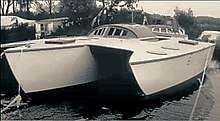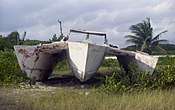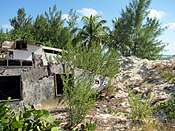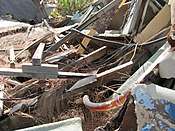Teignmouth Electron
The Teignmouth Electron was a 41-foot trimaran sailing vessel designed explicitly for Donald Crowhurst’s ill-fated attempt to sail around the world in the Golden Globe Race of 1968. She became a ghost ship after Crowhurst reported false positions and presumably committed suicide at sea. The journey was meticulously catalogued in Crowhurst's found logbooks, which also documented the captain's thoughts, philosophy, and eventual mental breakdown. Sold after its recovery, the vessel passed through several subsequent hands, being re-purposed and re-fitted as a cruise vessel and later, dive boat, before eventually being beached at Cayman Brac, a small Caribbean island, where its remains were still visible as at 2019 but in an advanced state of decay.

-cropped.jpg)

Design and construction
Construction on the Teignmouth Electron began in June 1968 after Crowhurst failed to acquire the vessel Gipsy Moth IV, previously sailed by Sir Francis Chichester in his 1967 circumnavigation.[1] The boat was in part funded by the town of Teignmouth, Devon, England, and business investor Stanley Best, who also invested in Crowhurst's business, Electron Utilisation. The ship was named in honor of the town and Crowhurst's business.
Crowhurst became convinced that the trimaran model, with its potential for extreme speed, would serve him best to win the race. The Electron was based on designs for Arthur Piver’s Victress-class trimaran. However, significant structural and aesthetic deviations from the original designs were made at Crowhurst's request, in order to make the ship more suitable for the long journey through rough seas. Due to the significantly short window in which the boat was constructed, Crowhurst chose to have the hulls fabricated at Cox Marine Ltd. in Brightlingsea, then had the hulls shipped to L.J. Eastwood Ltd. in Brundall of Norfolk for final fit and completion.
The Brundall shipyard had two partners, John Eastwood and John Elliot. Eastwood acted as the main boatbuilder and engineer. According to Eastwood, many of the Electron's modifications were made in order to accommodate numerous technological and electronic inventions meant primarily for preventing the ship from capsizing in large seas. Because of its multi-hulled design, a trimaran is fast and fairly stable due to its weight dispersal over a large surface area. However, it cannot right itself if capsized like a mono-hulled ship would be able to. Crowhurst, anxious about the rough waters of the Roaring Forties and Cape Horn, had plans to install a buoyancy bag on the mainmast. This bag would inflate when the main computer on board sensed the boat was tipping. In theory, this would keep the boat at a rightable 90 degree angle. However, due to severe time and capital constraints, the main computer was never installed in the ship.
The additional weight of the buoyancy bag meant that the main mast had to be shortened by four feet from the original Victress model. The masts were made of aluminium alloy and were supplied by International Yacht Equipment Ltd. Extra bulkheads were also added—four each on the starboard and port side floats and three in the center hull. This translated to a deck design with an unusual amount of hatches. Additionally, these hatches were inadequately sealed due to a shortage of the appropriate stock of soft rubber needed to create a watertight seal. A harder, less malleable alternative was substituted which made the possibility of leaking much greater.
On the deck, two layers of 3⁄8-inch marine ply were used instead of the typical single layer. The double layering allowed for staggering the joints to alleviate any high-stress points that could buckle under the extreme expansion and compression they would face in the open ocean. The design included four reinforced crossarms with three—or in the case of the forward crossarm, four—vertical runs of plywood spanning the entire beam of the boat, connecting the port, main hull and starboard floats together. This required the main mast to be positioned atop the forward, reinforced crossarm.
Additionally, against Crowhurst's wishes and the original Victress designs, the decking was painted with double polyurethane paint as opposed to being sheathed in a fibreglass skin as the hulls had been by Cox Marine Ltd. While this did not present a structural issue, it created greater aesthetic deviation from the Victress design. The boat was completed just days before the race's deadline, leaving testing and innumerable details incomplete and the boat roughly 200 percent over its projected budget. On October 31, 1968, the last day possible to begin the race, the Teignmouth Electron was towed from Teignmouth Harbor and sailed into the Atlantic.
The Electron was designed to be very sparse, with a sizable reduction of living space that was intentionally designed to reduce weight, wind and water resistance. The original designs called for a high enclosed wheelhouse superstructure that Crowhurst abandoned for a flush deck that only allowed for a small rounded “doghouse”.
Onboard and exterior equipment
The Electron's sail configuration consisted of No. 1 mainsail, No. 1 mizzen sail, working staysail, and working jib. On the exterior deck were an inflatable raft, a rubber dingy, an anchor mounted on the starboard bow of the deck, and a stainless tube pulpit mounted to the bow of the boat. The boat also housed a Hasler self-steering system with a wind vane and servo blade as well as a Hengist-Horsa wind speed and direction indicator.
Below deck the built-out consisted of a built-in writing and eating table with a small red cushioned seat that would have hidden the ‘main computer’ but instead obscured a tangle of carefully colour-coded, but unconnected, wires that hung throughout the cabin. On the starboard side was a built-in chart table with a vise mounted to it. On the port side mid-stay, was a small galley (kitchen) with a stainless sink basin and small faucet with water supplied by an internally mounted water tank. Wood cabinets were above the sink and cooking burner. Aft was the small single berth. Overall, the living quarters were considerably smaller than those of Crowhurst's competition.
For communication, Crowhurst had a Marconi Kestrel radio-telephone, a Racal RA 6217 communications receiver, a Shannon Mar 3 transmitter/receiver, headsets, Morse keys, switch panels, and gross amounts of radio spares. Powering the electronics on the boat was an Onan petrol-driven generator that was seated under the cockpit where it would be at risk of continuous exposure to water in rough weather. The galley consisted of a small burner, a pot and sink with freshwater supplied from 8 Plysu containers holding part of his water supply which were connected to four large fixed water tanks, mounted inside the port and starboard side floats. The typical “Victress” cabin also featured built-in cabinetry; Crowhurst allowed a few units of shelving in the galley, but replaced most of it with lightweight Tupperware plastic containers for storing food, electronic components and a second-hand Bell and Howell 16mm camera and Uher tape recorder that had been provided by the BBC for documenting the journey. Crowhurst brought aboard only 5 books: Albert Einstein’s Relativity, the Special and the General Theory; Shanties from the Seven Seas; Servomechanisms; The Gypsy Moth Circles the World; and Mathematics of Engineering Systems.
In provisions, Crowhurst had dried vegetables, powdered milk, tea, porridge, butter, powdered eggs, bread, jam, champagne, mustard, a few tins of beer, rum, barley wine, and various tinned or dehydrated meals.
Sailing history
The attempted launch of the Teignmouth Electron took place on September 23 into the river at Brundall when Crowhurst's wife, Clare, tried to christen the ship by breaking a bottle of champagne against the boat's hull. However, the bottle didn't shatter and instead bounced off the hull, which prompted John Eastwood to take the bottle and properly break it against the boat, completing the launch.
The Electron was tested in open water from Brundall, down the River Yare, to Teignmouth. The voyage was meant to be completed in three days, but instead took two weeks. On this voyage, due to an abrupt halt commanded by Crowhurst to avoid a chain ferry, the Electron was swung into the river bank by the tide and her starboard float was holed. On this maiden journey, it was also discovered that the Electron could not perform windward, an issue Crowhurst would encounter again once the race began.
The Electron set sail from Teignmouth Harbour at 4:52 pm on October 31, 1968. Based on his logs, it is believed Crowhurst's voyage lasted in total 243 days – his last log entry dated June 24, 1969. The Electron was at sea for a total of 252 days before being found ghosting, adrift a shipping lane.
Upon starting the race the boat immediately experienced problems. Three days into the journey, the Hasler self-steering gear shed two screws, which led Crowhurst to discover that he had no spare screws or bolts aboard the craft. He salvaged screws off of non-necessary gear but any more shedding would result in loss of control of the craft while Crowhurst was not at the helm. His logline, which judged distance traveled, was also caught on the boat's rudder and the rotator jammed. His Racal radio receiver also did not transmit, a problem Crowhurst struggled with for four days before realizing it had just been a blown fuse. On November 5, he discovered that the port bow float and tack were taking on water, and the whole compartment had been flooded up to the deck.
Unfortunately, as he attempted to bail the water, the 15-foot seas came pouring back into the opening. On Wednesday, November 13, a leak in the cockpit hatch flooded the engine compartment and his Onan generator. Design flaws made the Electron difficult to steer, resulting in a bizarre and erratic zigzag sailing pattern. On November 15, in the face of extreme problems with the craft, Crowhurst set about calculating the pros and cons of continuing the race. Eventually, he came to the conclusion that dropping out would only be a temporary failure, one that could be mended with an additional try at the Golden Globe in the future. On November 16, with his generator finally repaired, he sent off a press report to his press coordinator Rodney Hallworth, stating that he was “going towards Madeira” even though he was less than 200 miles from his last position which had been recorded as “heading Azores”. However, Crowhurst's logs prove to be fairly correct in providing location up to December 1. It is on Friday, December 6 that he begins to actively construct a false navigational record, giving himself up to 243 mile per day runs in a communication to Hallworth on the 10th. In some cases, his fabricated mileage is almost triple his actual achieved distance.
On December 21, Crowhurst reported, “split skin of starboard float.” The internal wooden frames had come away from the plywood, leaving a split half-way along the float. He attributes the hole to the workmanship of the Eastwood shipyard, as it had formed in the fiberglass that they had laid on the floats. This split grew the longer Crowhurst neglected to attend to it, and as he had no means of repairing such a sizable hole on board, he would have to stop for the needed supplies. For nearly a month he meandered on the coast of South America, weighing his options.
On March 6, 1969, he dropped anchor at Rio Salado, landing in Argentina at 8:30 am, and grounded himself in the quickly receding tides in order to repair the sizeable hole. He stayed for two days and set sail again on March 8.
Shortly after midnight on May 21, Lieutenant-Commander Nigel Tetley, the only other competitor still in competition with Crowhurst, watched as his “Victress” trimaran sank while awaiting rescue on his rubber life-raft 1,200 miles from England. After providing false readings to the race organizers for months, Crowhurst reached a point in his calculations where his true position could coincide with his fake position in the race, and at this point could safely radio the race organizers. Here, Crowhurst was informed that most of the other sailors had either dropped out of the race or that their boats had fallen apart mid-course, leaving the Teignmouth Electron in position to not just finish, but actually, win the race. It is believed that Crowhurst had up to this point anticipated finishing the race, but not to win it, thus avoiding the scrutiny that would no doubt occur for the winner. Upon hearing the news about Tetley, Crowhurst's psychology changed more radically.
Final days
On June 23, he entered his last sun-sight in his logbook and entered no more navigational data at any point afterward. In the hours before what would become his final mental collapse, he repeatedly tried to reach his wife Clare on the telephone, but was foiled by failing equipment. On June 24, Crowhurst began writing a 25,000-word manifesto on life, escape, time-space, and defeating time to change from “first order differentials” to “second order differentials” – at times lucid, at other moments, especially to the end, cryptic and incoherent.
His last log entry is dated June 24, 1969; the final radio transmission was made on June 29, 1969. On July 1 at 10:29 AM British Standard Time, Crowhurst documented his final confession, ending with “It is finished—it is finished IT IS THE MERCY” at 11:20 and 40 seconds. He wrote “It has been a good game that must be ended at the // I will play this game when I choose I will resign the game // There is no reason for harmful”. It is presumed that shortly after this, Crowhurst, his chronometer, and falsified log book all went overboard while the Electron was set to continue sailing at roughly two knots.
The abandoned craft was found at 7:50 am on July 10, 1969, by Royal Mail Ship Picardy captained by Richard Box at latitude 33° 11’ North, longitude 40° 28’ West, about 1,800 miles from England. This was very close to where the famous ghost ship Mary Celeste had been found almost a hundred years before off the coast of the Azores. As designated by maritime tradition, three foghorn blasts were given by the Picardy, and when no response by flare, flag or horn was returned, a team of sailors boarded the trimaran to find it unkempt and bearing signs of life, work and cooking, but nothing overtly suspicious.
What was clear was that the craft was devoid of life and had obviously been abandoned many days before. Placed in plain view were detailed logbooks outlining forged coordinates, a logbook outlining his true coordinates, as well as the 25,000-word manifesto that he believed to be his ultimate life's work detailing “instructions” written directly to humankind on attaining transcendence. After the analysis of the logbooks, it was determined that the boat had been abandoned nine days prior to its discovery.
Aftermath
After its discovery by the RMS Picardy, the Teignmouth Electron was taken to Florida and later to Jamaica. The Electron's British funders, wanting to recoup some of their financial investment but also put aside the tragic and embarrassing event, sold the boat in auction sight unseen. In Jamaica, the boat was purchased by Kingston hotelier and businessman Larry Wirth, who used it as a private pleasure craft until 1973, when it was sold to Roderick "Bunny" Francis, a young entrepreneur with a fledgling trawling company.[2]. Francis made significant alterations to the boat to alleviate the austere conditions Crowhurst had demanded within the living quarters, and to make the boat less difficult to maneuver and sail.
To transition the boat into a leisure craft, Francis had Crowhurst's streamlined doghouse opened up and built taller, and added much larger windows. With this, the main cabin was redesigned so it could sleep up to 10 people. Francis also modified the stern significantly—removing the fin keep and adding a skeg with propeller shaft for a trolling motor. Topside the stern, two seating blocks were added to provide a seating position for the helmsman. A number of the deck hatches were modified, and the circular covers were cut and made square with a more easily removable hatch. Francis then had the entire boat fibreglassed and repainted. At this point, the port of registration (Bridgwater) was painted below the name of the vessel.
Francis also made a number of changes with the purpose of correcting and smoothing the erratic sailing pattern that Crowhurst experienced. He removed the daggerboards on the starboard and port side floats. He constructed a new keel on the main hull—twelve feet long, four inches wide, with a six-inch protrusion that was anchored to the main hull and fibreglassed over. During this period in Jamaica, the boat mostly stayed moored and was sailed for short pleasure cruises in Montego Bay.
Due to the difficult economic climate in Jamaica in the 1970s, Francis sold the boat in 1975 for $12,000 to George McDermot who kept and sailed the boat out of what is now Morgan's Harbor. In 1977 George McDermot was moving his family to Miami and sold the boat to his brother Winston McDermot. After a short while, Winston moved his scuba diving operation, and with it the Teignmouth Electron to Cayman Brac, a smaller sister island about 160 km to the east of Grand Cayman. The boat remained in service as a diving boat until 1983, when it hit bottom and sustained minor damage. To repair the damage the boat was hauled out onto the beach for repairs. Unfortunately while being lifted with a crane it dropped and sustained further damage to the hull. Aware of the boat's history, McDermot had eventual intentions to repair and even restore her closer to Crowhurst's original design, and commenced by removing the huge cabin and began constructing a smaller one; during the start of the restoration, he came across a supply of Crowhurst's emergency rations, secreted in a sealed compartment on the underside of the arm between the main hull and port float (three more such compartments remained unopened).[2] Unfortunately, due to the attention required by other aspects of his business, the full restoration did not materialise; the vessel was subsequently damaged by Hurricane Gilbert during September 1988 and plans for its restoration abandoned.
Over the years, various elements have been removed, including the aluminium mast and rigging and most of the parts of value including the metal fittings and tie downs, leaving a mostly empty hull.[3] In 1998, the hull was essentially intact,[4][5] however since that time the remains of the vessel continued to deteriorate.[6] Well past the point of preservation, in 2007, McDermot sold the boat to American artist, Michael Jones McKean, who planned to create a full-blown replica of the boat in its dilapidated state as an artistic piece.[7] In 2017, McKean led a group of researchers and archaeologists to Cayman Brac to produce an archival quality, high resolution digital scan of what remained of the Electron and the surrounding site (see "External links").
What remains of the boat has exerted a fascination and poignancy for viewers and a small number of visitors over the years, on account of its association with the initial optimism and eventual tragic demise of its designer and original sailor, Donald Crowhurst. Artist McKean, who is the latest owner of the remains, wrote in 2007 that the boat "stands in relation to a desperate belief in something bigger than any of us individually. We have these feelings that are embedded deep inside our coding as people, to hope and dream and aspire to great, impossible things. But these dreams, in there [their] hugeness have the potential to unravel us. They move us to action, but in their grandiose scale become impossible to understand; they seduce us but have the possibility [to] finish us. For me the boat lives on as a relic, or monument to this idea."[8]
Replica
In 2015, Heritage Marine in England began construction of an elaborate, full-scale replica of the Teignmouth Electron. By piecing together photos as well as original diagrams, an extremely detailed reconstruction was achieved. The build was funded by StudioCanal and the BBC for a film depiction of the Crowhurst/Electron saga titled The Mercy. The film, starring Colin Firth, was released in February 2018.
The replica is now owned by artist Michael Jones McKean and is currently in dry docked in storage on the island of Malta.
Another recreation of the main interior cabin was made for the 2006 documentary Deep Water. The lead designer was Jayne Linz Roberts. This replica no longer exists.
Gallery
 Teignmouth Electron (boat), remains at Cayman Brac, by Packmatt, 2001
Teignmouth Electron (boat), remains at Cayman Brac, by Packmatt, 2001 Teignmouth Electron (boat), remains at Cayman Brac, by Packmatt, 2001
Teignmouth Electron (boat), remains at Cayman Brac, by Packmatt, 2001 Teignmouth Electron (boat), remains at Cayman Brac, by Packmatt, 2001
Teignmouth Electron (boat), remains at Cayman Brac, by Packmatt, 2001 Teignmouth Electron (boat), remains at Cayman Brac, by Lee Shoal, 2011
Teignmouth Electron (boat), remains at Cayman Brac, by Lee Shoal, 2011 Teignmouth Electron (boat), remains at Cayman Brac, by Lee Shoal, 2011
Teignmouth Electron (boat), remains at Cayman Brac, by Lee Shoal, 2011 Teignmouth Electron (boat), remains at Cayman Brac, by Lee Shoal, 2011
Teignmouth Electron (boat), remains at Cayman Brac, by Lee Shoal, 2011 Teignmouth Electron (boat), remains at Cayman Brac, by Lee Shoal, 2011
Teignmouth Electron (boat), remains at Cayman Brac, by Lee Shoal, 2011 Teignmouth Electron (boat), remains at Cayman Brac, by Lee Shoal, 2011
Teignmouth Electron (boat), remains at Cayman Brac, by Lee Shoal, 2011 Teignmouth Electron (boat), remains at Cayman Brac, by Lee Shoal, 2011
Teignmouth Electron (boat), remains at Cayman Brac, by Lee Shoal, 2011
References
- The Strange Last Voyage of Donald Crowhurst, Nicholas Tomalin, Ron Hall, 1970
- www.teignmouthelectron.org: "Teignmouth Electron - The Mystery Part III". Archived copy via Internet Archive, date 29 December 2004
- "The Wreck of the Teignmouth Electron", Pangea Exploration, March 23, 2014, http://panexplore.com/teignmouthelectron/
- Tate Gallery, UK: Tacita Dean: Aerial View of Teignmouth Electron, Cayman Brac 16th of September 1998
- Tacita Dean, 1999: "Teignmouth Electron". Book Works in association with the National Maritime Museum, 72 pp. ISBN 978-1-870699-36-5
- www.teignmouthelectron.org: "Teignmouth Electron - 2001 by Edward Arlen". Archived copy via Internet Archive, date 29 December 2004
- "A Race Too Far", p. 296.
- Michael Jones McKean: 2007 press release on Teignmouth Electron (archived copy) (original no longer accessible)
Bibliography
- Nicholas Tomalin and Ron Hall, 1970: "The Strange Voyage of Donald Crowhurst". Hodder & Stoughton, 317 pp. ISBN 9780340129203 (Subsequent editions have the revised title "The Strange Last Voyage of Donald Crowhurst").
- Tacita Dean, 1999: "Teignmouth Electron". Book Works in association with the National Maritime Museum, 72 pp. ISBN 9781870699365
- Chris Eakin, 2009: "A Race Too Far". Random House, 336 pp.
External links
- Contemporary photographs of Crowhurst and the Teignmouth Electron from the archives of the Sunday Times, 1968-1969
- Image search result for "Donald Crowhurst sailor" on Getty Images
- Alamy stock images of the remains of the Teignmouth Electron on Cayman Brac, as they were in 1991
- Tate Gallery, UK: Tacita Dean: Aerial View of Teignmouth Electron, Cayman Brac 16th of September 1998
- Bookworks.org.uk: Tacita Dean: "Teignmouth Electron", a book of photographs of the remains of the vessel on Cayman Brac, published in 1999
- Archived page from www.teignmouthelectron.org (site no longer accessible), with photographs of the boat in 1991, March 2003 and January 2004 (Ian Murray/Nicky Watson)
- Some 2006(?) polaroids of the boat taken by future owner Michael Jones McKean...
- left side
- stern and bow
- night shot ... (some additional images here)
- A set of 2008 photographs of the remains of the boat (plus a different set here)
- Images of the boat in 2013, included in this 2013 tourist visit account
- Michael Jones McKean: "Twelve Earths" art project - includes 2017 images of the Teignmouth Electron
- Teignmouth Electron model - flythrough of the remains of the boat (computer rendering) on Vimeo, based on a digital scan of the remains in 2017
- A set of 2017(?) photographs of the remains of Teignmouth Electron on Cayman Brac, at the National Gallery of the Cayman Islands: The Teignmouth Electron (19 years after Tacita Dean)
- Location of the remains of Teignmouth Electron on Google Maps
- Google Maps street view looking towards the remains of the Teignmouth Electron from South Side Road W, Cayman Brac, June 2019
- 2017 preview article for film "The Mercy" on www.classicyacht.tv, including a picture of the replica Teignmouth Electron under construction at Heritage Marine - Downs Road Boatyard